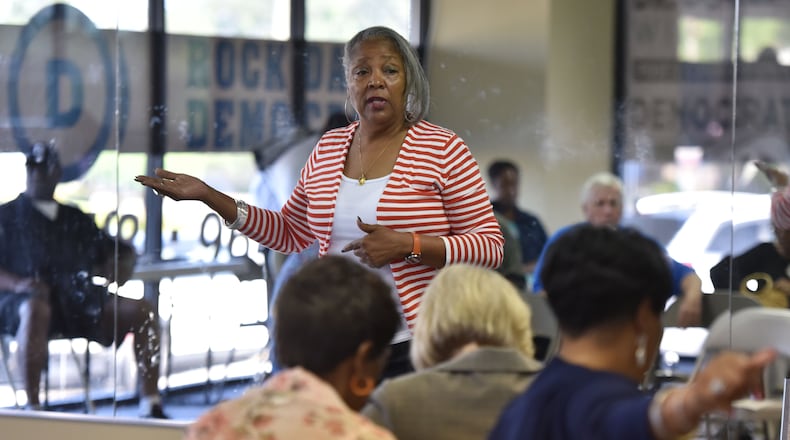Racial shifts
Nationwide, four Georgia counties experienced the four largest percentage-point drops in white residents between 2000 and 2013, according to a Pew Research Center report that includes only counties that had at least 10,000 residents in 2013. Contributing factors include the reverse of the Great Migration, with more blacks moving South, and the growth of the nation’s Hispanic and Asian populations.
County / Percentage of White Residents in 2000 / Percentage of White Residents in 2013 / Percentage Point Change
1. Rockdale / 72.8 / 37.8 / 34.9
2. Henry / 80.1 / 49.8 / 30.3
3. Douglas / 76.0 / 46.2 / 29.8
4. Gwinnett /67.0 /41.6 / 25.4
Elaine Davis-Nickens moved from Maryland to Rockdale County in 2007, seeking a slower pace of life near Atlanta, a place she had visited in the past.
The federal government retiree already had a friend in Rockdale and was attracted to the county’s “community feel” as well as its reasonable housing costs. Her mother, sister and brother followed within the span of a few years, relocating from the Washington, D.C.-area to Rockdale. Two of her grown children are now planning to make the same move.
Davis-Nickens and her relatives are part of the reversal of the 20th century’s Great Migration, when millions of African-Americans migrated North over decades to escape Jim Crow segregation laws and to find work. Rockdale and several other Atlanta-area counties stand out amid this pattern.
Between 2000 and 2013, Rockdale’s black population surged by 230 percent — from 12,733 to 41,957 — U.S. Census Bureau figures show. During the same time frame, the county saw the nation’s largest percentage-point drop in white residents at about 35 percentage points, according to a report released this year by the Pew Research Center in Washington. Nationwide among counties with at least 10,000 residents, Henry, Douglas and Gwinnett had the second-, third- and fourth-largest drops, respectively, as more blacks, Hispanics and Asians moved into the region.
“I made a lot of friends with people like myself who had migrated from other parts of the country,” said Davis-Nickens, now the chairwoman of the Rockdale County Democratic Party and the child of Southerners who migrated to the Washington area. “It was an easy shift.”
Population shift, political change
Sweeping political changes — and controversy — have paralleled the demographic shifts in the South. Rockdale, for example, voted for Barack Obama in the past two presidential elections after selecting Republicans in the previous five. And in 2008, Rockdale elected its first black county Board of Commissioners chairman, Richard Oden, a Democrat from Ohio. Four years later, the county elected its first black sheriff, coroner, Magistrate Court judge, Probate Court judge and tax commissioner — all Democrats.
While highlighting those Democratic victories Oden expressed concern about Rockdale’s “exodus” of white residents, calling it unfortunate.
“In order for this community and the region and the state to be a global community, everyone has to embrace diversity,” Oden said. “Everyone has to learn to live together as opposed to attempting to separate from one another.”
Blacks now make up 50 percent of Rockdale’s population, with whites accounting for 46 percent.
With change comes tension
Racial tensions in Rockdale boiled over in 2012, when a white Republican member of the county’s Board of Elections wrote an editorial about the county’s leadership. Posted on a conservative news website, the column metaphorically described the county as a “little white plane” that became blacker over time and was eventually hijacked by liberals he predicted would bring “crime, incompetence, cronyism and corruption.”
Critics said the column was racist and called on the writer, Jonny Brown, to resign from the elections board. Brown refused to step down. In a telephone interview with The Atlanta Journal-Constitution, Brown said much of his column was misunderstood. He denied his piece was racist, and he said he was standing up for the “working people who built this county, black and white.” He then took aim at the “thugs” he said are moving into Rockdale from Clayton and DeKalb counties.
“What we are getting in the county now is basically a bunch of thugs,” Brown said. “Our crime rate is skyrocketing.”
Statistics don’t bear that out. Rockdale’s Sheriff’s Office documented smaller numbers of robberies, assaults, burglaries, thefts and auto thefts last year than it had in any of the previous four years, though two categories of violent crime increased. Rockdale had three murders last year, up from two the year before. And Rockdale authorities investigated 12 rapes in 2014. That is up from seven in 2013.
Brown added that Democrats now outnumber Republicans in Rockdale and that the state of the county’s Republican Party is “pretty much in disarray.”
“It’s just about kaput,” he said.
Republicans seek to adapt
JaNice Van Ness, the chairwoman of the Rockdale Republican Party, disagreed with Brown’s column and called it “hurtful.” She also sounded optimistic about the county GOP’s future, saying it is striving to be more inclusive.
“Our goals are a little bit different than they have been in the past, doing more community outreach, building bridges between not just parties but also between different races as well,” said Van Ness, a former county commissioner who was unseated by a Democrat in 2014. “It’s a much more open, transparent party than we have seen in the past. And I’m really excited about it.”
Davis-Nickens is the source of some of the GOP’s troubles in Rockdale. She volunteered for Obama’s 2008 campaign in the county and has helped get Democrats elected to local offices in Rockdale.
“What has surprised people is that the change was so rapid,” she said about the Democratic Party’s gains in Rockdale.
Rockdale’s political changes are occurring amid the reversal of the Great Migration that started in the 1970s as more blacks migrated South, said William Frey, a demographer for the Brookings Institution, a public policy research group based in Washington.
“To the extent that Georgia is going to be a (politically) purple state — which a lot of people think will happen — it is going to be heavily because of this black migration,” said Frey, the author of “Diversity Explosion: How New Racial Demographics are Remaking America.”
Housing, community also factors in shift
Rockdale is also attracting blacks from other parts of metro Atlanta. Tonia Carson moved with her husband from Gwinnett County to the Avondale Springs neighborhood in Conyers in 2013.
“It just has everything one would want in a home — a tennis court, a pool and a playground for the children, which would be my grandchildren at this point,” said Carson, a New York City native who works as a management analyst for the U.S. Centers for Disease Control and Prevention. “It’s just a beautiful community to me.”
Carson said the affordability of homes in Rockdale was a major draw for her family. Rockdale’s median home price is $123,600, compared with $135,400 for DeKalb and $202,000 for Fulton County, according to zillow.com. She and other transplants cited the county’s walking trails and the Georgia International Horse Park and the Monastery of the Holy Spirit in Conyers.
“Honestly, I think you get a lot more for your money than you do in a lot of the northern suburbs,” said Jonathan Atwater, a local Realtor who grew up in the county and now lives in Conyers. “And it is a quiet area to live in. You are roughly less than 40 minutes from the city, but at the same time you can be in a rural environment in Conyers or you can live in your average suburban subdivision.”
Blacks are also moving to Rockdale from the West. Caroline Olok moved to Conyers from San Diego to be nearer to her sister, who lives in Covington. A native Ugandan who previously lived in Philadelphia, she is impressed with the county’s schools and its diversity.
“I have always loved Rockdale,” she said. “It’s close enough for me to get to Atlanta and still be away from Atlanta. It has grown tremendously, though. … Things have just changed so much. My goal was to really have my kids in a mixed community.”
About the Author
Keep Reading
The Latest
Featured




